How to Properly Use 100 Cotton Care Labels: A Step-by-Step Guide
Learn how to effectively use 100 cotton care labels for garment longevity and maintenance.

Overview:
The proper use of 100% cotton care labels involves understanding and following the maintenance instructions provided to enhance clothing longevity and prevent damage. The article emphasizes that consumer awareness is critical, as many individuals neglect these instructions, leading to premature wear; it also highlights that clear labeling can significantly improve customer satisfaction and reduce return rates.
Key Highlights:
- Cotton care labels provide essential maintenance information to enhance the longevity of clothing.
- A study found that 10.4% of participants rarely used care instructions, indicating a gap in consumer awareness.
- Proper understanding of care symbols can prevent damage and improve clothing maintenance.
- Common mistakes include ignoring label instructions and assuming all cotton garments require the same care.
- Higher education levels correlate with better use of care label information during purchases.
- Clear maintenance instructions can reduce return rates by up to 30%, enhancing customer satisfaction.
- Digital care labels, like QR codes, provide instant access to maintenance information, improving consumer engagement.
- Brands that invest in clear labeling and education can foster customer loyalty and promote responsible consumption.
Introduction
In the realm of fashion, cotton care labels serve as an essential guide for consumers, ensuring that garments are maintained properly for longevity and optimal appearance.
Despite their significance, a surprising number of individuals overlook the vital instructions these labels provide, leading to premature wear and dissatisfaction.
Recent studies reveal a striking gap in consumer awareness regarding care labels, underscoring the need for enhanced education and understanding.
With the right knowledge, consumers can make informed choices that not only protect their investments but also contribute to sustainable practices within the industry.
This article delves into the importance of cotton care labels, decoding their symbols, and outlining best practices for both consumers and brands to foster a culture of informed garment care.
Understanding Cotton Care Labels: Purpose and Importance
The 100 cotton care label on cotton maintenance tags serves an important function in advising individuals on the correct upkeep of cotton clothing, providing vital details that assist in avoiding harm during washing and drying procedures. By adhering to these guidelines, individuals can significantly enhance the longevity of their clothing. A recent study discovered that 10.4% of participants 'never' or 'almost never' used garment information, highlighting a gap in consumer awareness that could result in premature wear of clothing.
This gap is especially troubling considering that many participants in the laundry diary study owned or shared a washing machine, suggesting that access to maintenance information is readily available yet underused. Expert Elsayed Ahmed Elnashar emphasizes,
If producers want their customers to be able to maintain their clothes, they must include thorough maintenance instructions.
This feeling connects profoundly with the results of several case studies, including one that investigated disposal habits of cotton blends and synthetics, showing that comprehending maintenance instructions can affect how individuals choose to dispose of clothing.
Moreover, the research on Family and Consumer Science students uncovered a difficulty in identifying symbols, indicating the necessity for enhanced consumer education and customized designs that address specific demographics. Ultimately, understanding the 100 cotton care label not only encourages knowledgeable buying choices but also enhances the overall experience of clothing upkeep, ensuring both customer satisfaction and fabric longevity.
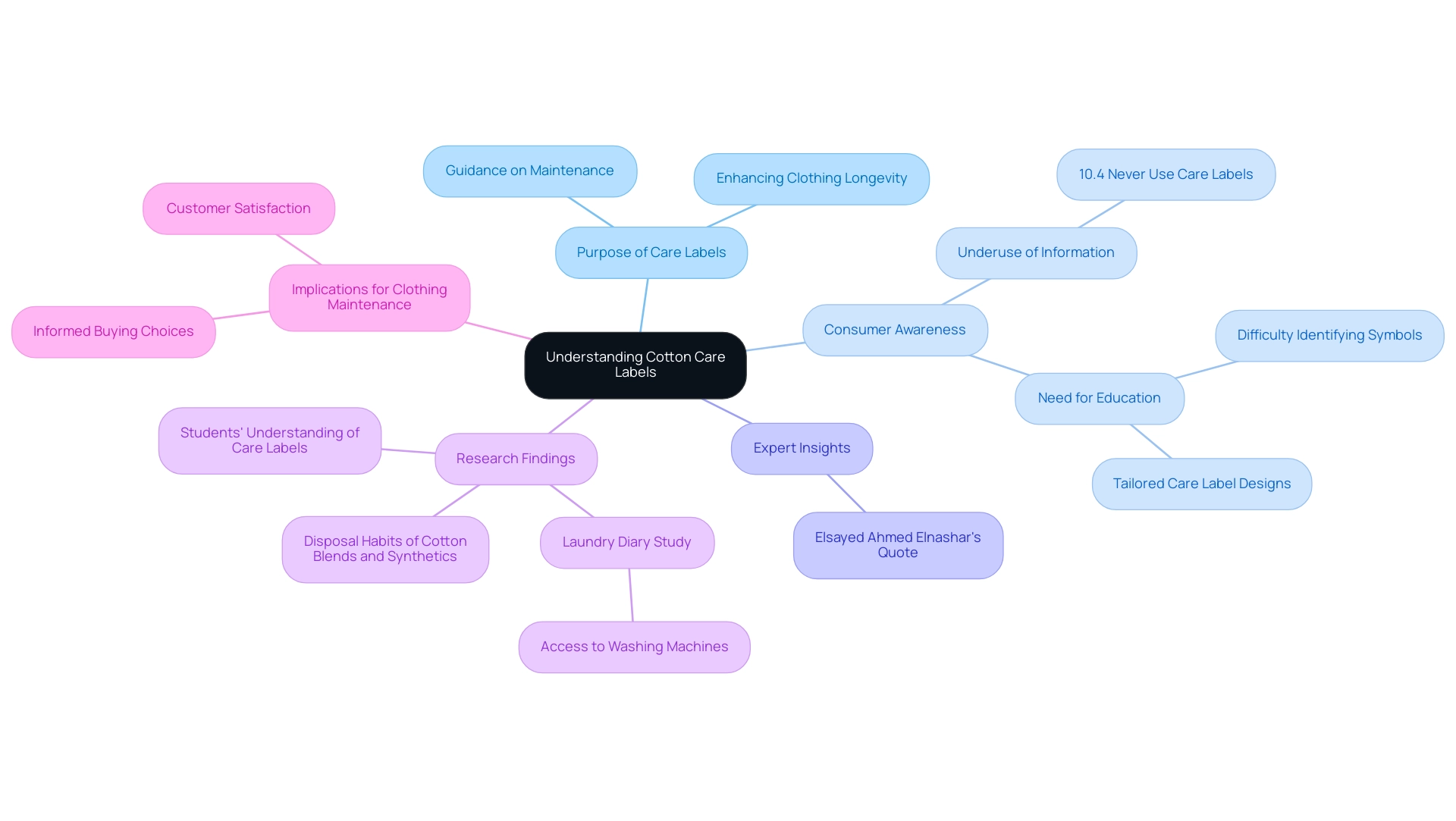
Decoding Care Symbols: How to Read Cotton Labels
The 100 cotton care label on cotton maintenance tags is a crucial instrument for preserving the durability and look of your clothing, showcasing an assortment of symbols that direct appropriate washing, drying, and ironing methods. For instance, a washing machine symbol accompanied by a number signifies the maximum washing temperature, which is essential to observe—typically not exceeding 30° C for optimal fabric maintenance. Following these garment instructions is essential, as it avoids possible infractions and guarantees conformity to regulations.
A triangle symbol represents the use of bleaching agents, while a circle indicates specific dry cleaning instructions. Understanding these symbols is vital, as they can significantly reduce the risk of damaging your items by following the 100 cotton care label. For example, the case study titled 'Hot Wash Instructions' highlights that hot wash settings (70°C and 95°C) are common for cotton items, allowing for maximum cleaning efficiency.
Expert advice suggests:
Iron high. The temperature should not exceed 390°F (200°C)—the equivalent of the cotton or linen setting. Iron the item while damp or spray with water before pressing.
Delicate garments should be ironed from the back or through a cloth. Furthermore, recent research by Gorm Gabrielsen and Jesper Clement examines consumer comprehension of product tags, highlighting the necessity for education on interpreting these symbols effectively. Hence, always check the 100 cotton care label before washing to ensure compliance with the suggested maintenance guidelines, thus protecting your investment in quality clothing.
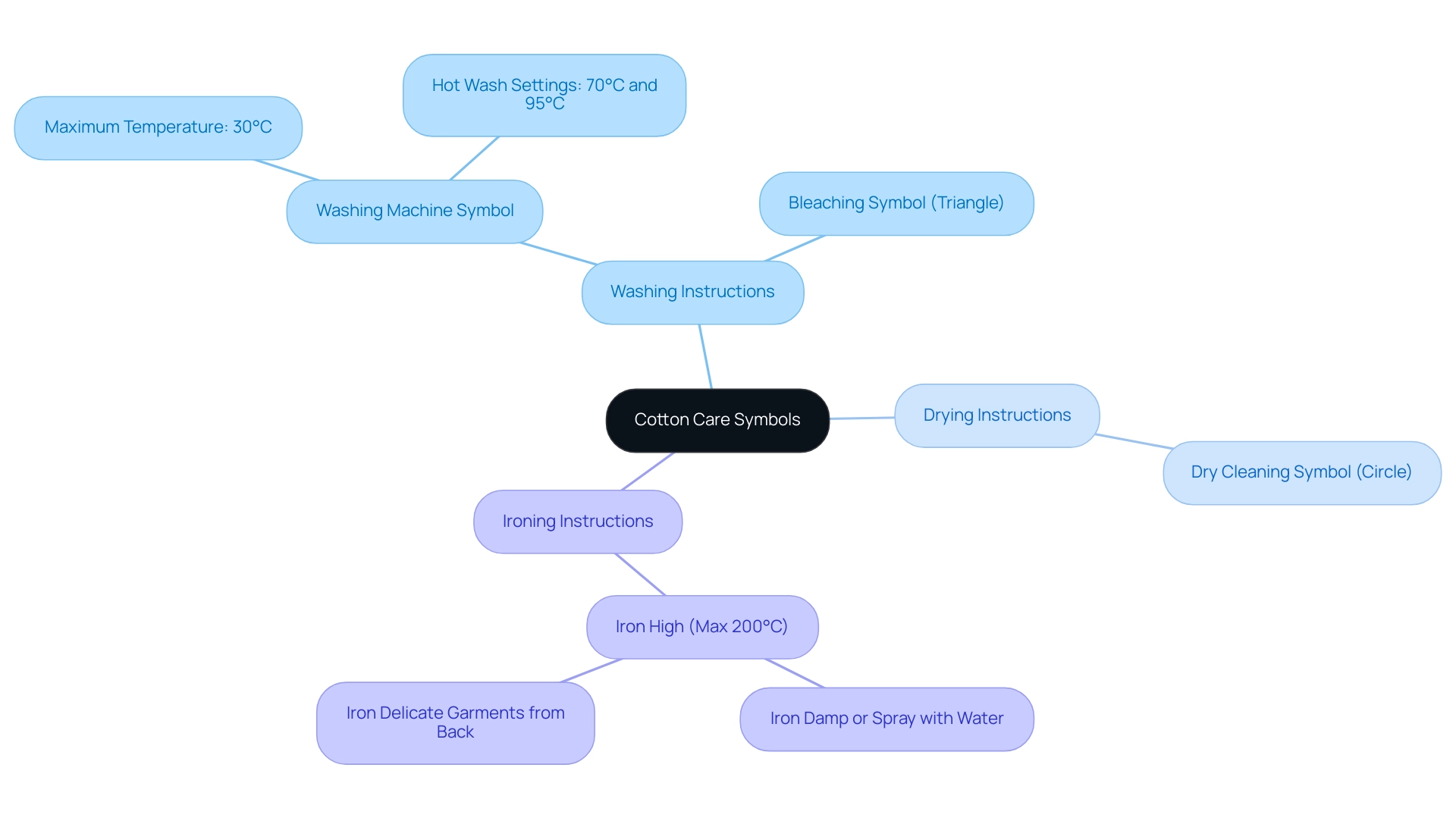
Best Practices for Attaching Cotton Care Labels
When attaching cotton care tags, it is essential to ensure they are securely sewn into a seam or a discreet area of the garment. Using high-quality thread that matches the fabric not only reduces visibility but also improves durability, which is essential for preserving the item's integrity over time. The typical lead time for producing fashion trims, tags, and markers varies from 25 to 60 days, emphasizing the significance of prompt attachment to prevent production delays.
The placement of the tag should strike a balance between visibility and unobtrusiveness, ensuring that it is easily accessible to consumers without detracting from the garment's overall design and comfort. As Mariusz Wilczek, Marketing Specialist at SilkPLM, observes, 'Fashion brands play a crucial role in your brand and shape how customers perceive your product.' Therefore, careful consideration of placement is vital to prevent the tag from becoming detached after multiple washes.
Correctly affixed maintenance tags, such as the 100 cotton care label, not only enhance the professional look of the clothing but also ensure that the maintenance guidelines stay clear and accessible to buyers, ultimately fostering durability and contentment with the item. Furthermore, comprehending the different kinds of tags utilized in clothing, as explored in a case study, emphasizes how each fulfills a particular role, improving buyer options and adherence to safety and maintenance details.
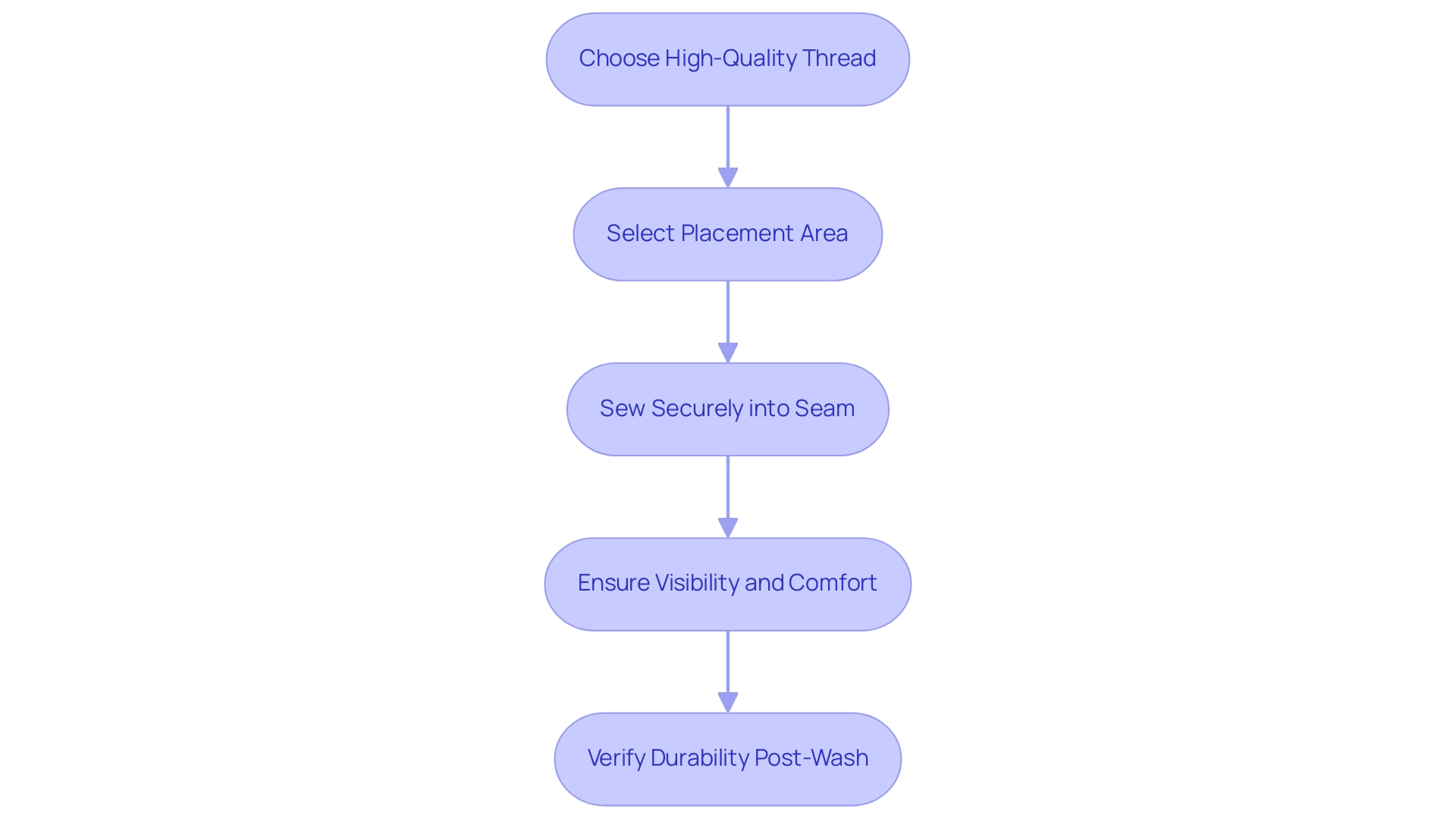
Common Mistakes to Avoid with Cotton Care Labels
One common oversight among consumers is the disregard for label instructions, which can lead to improper washing or drying techniques that ultimately damage the fabric. Misconceptions abound, particularly regarding the assumption that all cotton clothing items are interchangeable in terms of maintenance; various fabric blends often necessitate tailored attention. Additionally, excessive heat during ironing can cause scorching, further compromising the garment's quality.
To maintain the quality of cotton clothing, it is crucial to thoroughly read and follow the instructions provided. Recent findings indicate that higher education levels correlate with increased dependence on label information during apparel purchases, underscoring the need for consumer education on these common pitfalls. Furthermore, addressing the confusion surrounding new CGSB symbols is crucial; focus group feedback revealed that many participants expressed confusion and frustration with these symbols, describing them as complicated and non-intuitive.
This emphasizes the necessity for clear guidance in garment maintenance. The significance of cotton maintenance is further underscored by the recent celebration of the third official UN World Cotton Day on October 4, 2023, which emphasizes the importance of proper maintenance practices in the cotton industry. By promoting awareness and understanding among buyers, brand owners can significantly enhance customer satisfaction and loyalty, ultimately leading to a more positive association with their products.
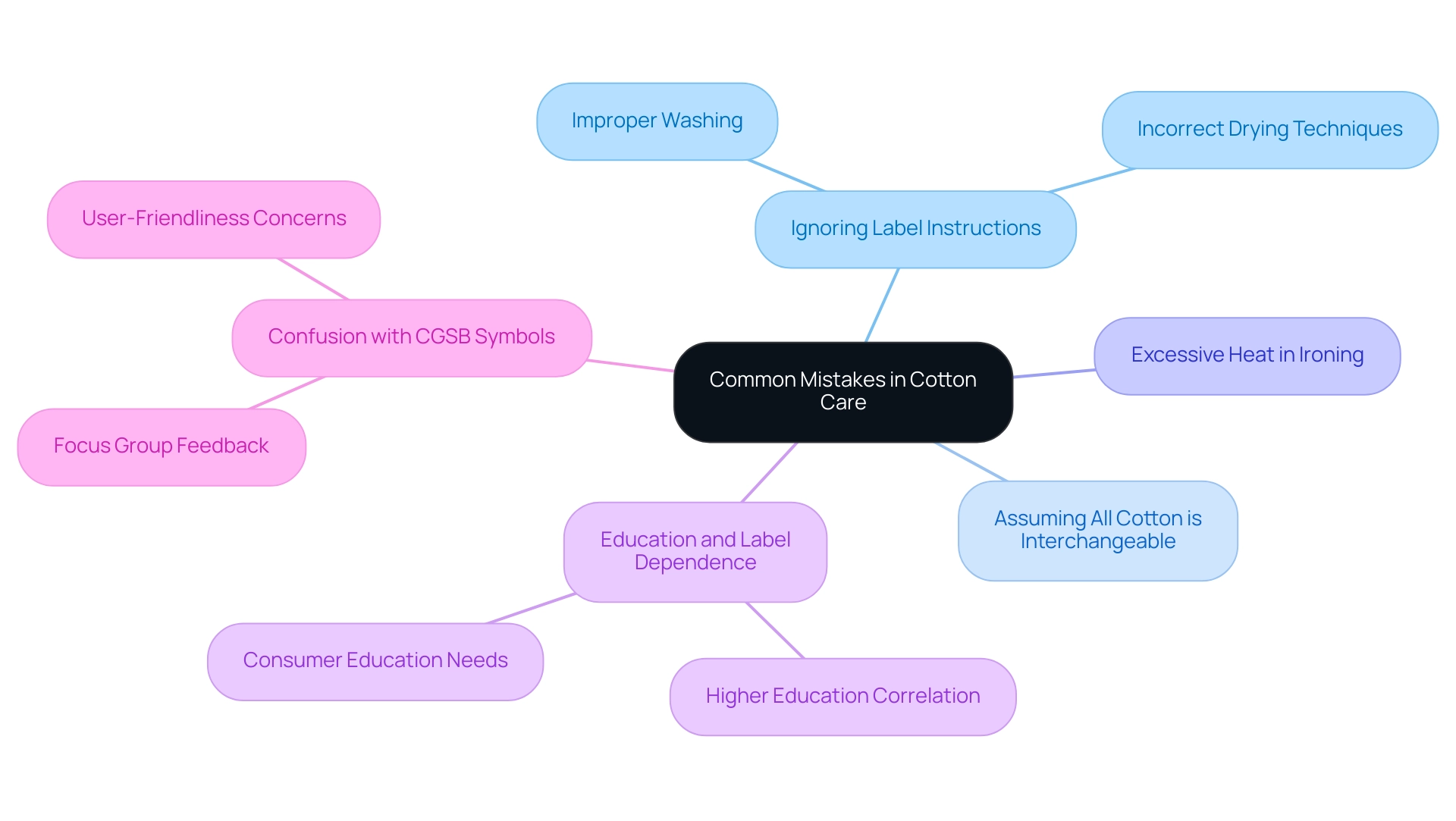
The Benefits of Using Cotton Care Labels in Fashion
In the fashion sector, the introduction of the 100 cotton care label goes beyond simple clothing upkeep; it greatly enhances brand reliability. Research indicates that clear maintenance instructions can reduce return rates by up to 30%, addressing consumer misunderstandings regarding garment upkeep. By offering detailed guidance on appropriate maintenance, brands can effectively minimize these issues, thereby enhancing customer satisfaction.
Moreover, with OpsNinja's quality inspection and audit solutions, brands can ensure their tags meet the highest standards, reinforcing their dedication to quality and safeguarding against negative feedback. Furthermore, the 100 cotton care label serves as an essential educational resource, educating individuals about sustainable practices and the significance of appropriate garment maintenance. This fosters a deeper connection between brands and their customers, positioning brands as advocates for responsible consumption.
As P Khude observes in the International Journal of Innovative Research in Science, Engineering and Technology, 'The Importance's of Labeling in Apparels and Textiles' emphasizes that the significance of labeling in the apparel and textile sectors cannot be overstated. Furthermore, the Loi AGEC law in France emphasizes sustainability in the fashion industry, highlighting the need for brands to adopt practices that not only comply with regulations but also inform the public. By investing in premium cotton tags, alongside OpsNinja's solutions, brands can enhance their reputation, strengthen customer loyalty, and ultimately promote favorable business results.
Digital care labels, which provide consumers with instant access to care information via QR codes or NFC tags, further enhance this educational aspect, making it easier for consumers to engage with the brand. To see how OpsNinja can help protect your brand from negative reviews and ensure quality customer experiences, contact sales or create a free account today.
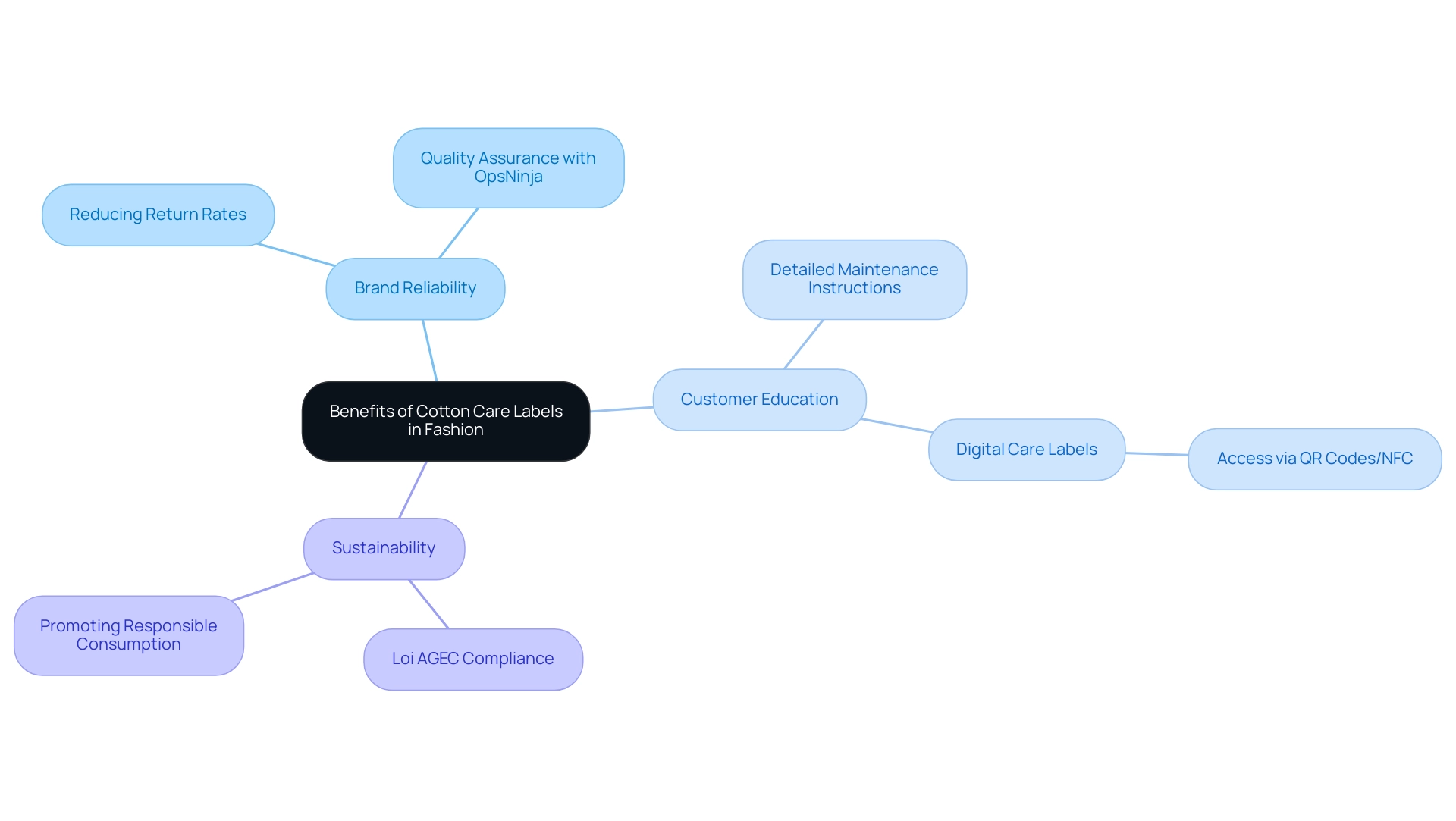
Conclusion
Understanding cotton care labels is essential for both consumers and brands, as these labels serve as critical guides for maintaining the quality and longevity of garments. The article highlights the significant gap in consumer awareness regarding care instructions, with many individuals failing to utilize the information available to them. This oversight can lead to premature wear and dissatisfaction, emphasizing the need for enhanced education about the importance of these labels.
Decoding the symbols on cotton care labels is equally crucial. By understanding the specific instructions related to washing, drying, and ironing, consumers can prevent damage and maintain the appearance of their clothing. The article underscores the importance of compliance with these care instructions to safeguard investments in quality apparel. Furthermore, best practices in label attachment and design are discussed, illustrating how proper positioning and durability can enhance consumer experience and satisfaction.
Common mistakes, such as disregarding care label instructions and the assumption that all cotton garments require the same treatment, are also addressed. The article calls for a concerted effort to educate consumers on these pitfalls, reinforcing the idea that informed garment care contributes significantly to sustainability and brand loyalty.
Finally, the benefits of using cotton care labels extend beyond garment maintenance; they bolster brand credibility and foster a responsible consumer relationship. By investing in clear, informative care instructions, brands can enhance customer satisfaction, reduce return rates, and promote sustainable practices. As the fashion industry continues to evolve, prioritizing the education and understanding of cotton care labels will not only protect consumer investments but also contribute to a more sustainable future.



